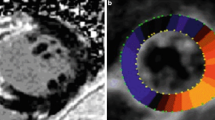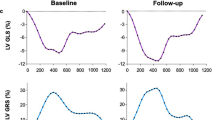Abstract
Assessment of transmural extent (TME) of necrosis after acute myocardial infarction (MI) remains a major problem in clinical practice. The study sought to determine whether speckle tracking imaging (STI) could differentiate transmural from nontransmural acute MI by assessment of endocardial and epicardial torsion. TME of infarct was measured by contrast-enhanced magnetic resonance imaging. Patients were divided into two groups according to TME (transmural MI group [TME ≥ 50 %, n = 36] and nontransmural MI group [TME < 50 %, n = 35]). As a control group, 30 subjects without evidence of structural heart disease were included. Conventional echocardiography and STI were done in controls and patients before and 1 month after percutaneous coronary intervention. Compared with control subjects, endocardial and epicardial torsion in patients with transmural and nontransmural MI were all extremely decreased (all P < 0.01). One month after percutaneous coronary intervention, there was no significant increase in endocardial and epicardial torsion in transmural MI patients. However, apical rotation and left ventricular torsion resumed slightly but significantly in the epicardium (but not endocardium) in patient with nontransmural MI (3.11 ± 0.81 vs. 4.37 ± 1.15°, P < 0.01; 3.69 ± 1.07 vs. 5.52 ± 1.89°, P < 0.01, respectively). The combined evaluation of endocardial and epicardial torsion by STI may be used to differentiate transmural from nontransmural MI after revascularization.



Similar content being viewed by others
References
Jugdutt BI, Khan MI (1992) Impact of increased infarct transmurality on remodeling and function during healing after anterior myocardial infarction in the dog. Can J Physiol Pharmacol 70:949–958
Kloner RA, Ellis SG, Lange R, Braunwald E (1983) Studies of experimental coronary artery reperfusion. Effects on infarct size, myocardial function, biochemistry, ultrastructure and microvascular damage. Circulation 68:8–15
Fieno DS, Kim RJ, Chen EL, Lomasney JW, Klocke FJ, Judd RM (2000) Contrast-enhanced magnetic resonance imaging of myocardium at risk: distinction between reversible and irreversible injury throughout infarct healing. J Am Coll Cardiol 36:1985–1991
Kim RJ, Fieno DS, Parrish TB, Harris K, Chen EL, Simonetti O, Bundy J, Finn JP, Klocke FJ, Judd RM (1999) Relationship of MRI delayed contrast enhancement to irreversible injury, infarct age, and contractile function. Circulation 100:1992–2002
Shan K, Constantine G, Sivananthan M, Flamm SD (2004) Role of cardiac magnetic resonance imaging in the assessment of myocardial viability. Circulation 109:1328–1334
Chan J, Hanekom L, Wong C, Leano R, Cho GY, Marwick TH (2006) Differentiation of subendocardial and transmural infarction using two-dimensional strain rate imaging to assess short-axis and long-axis myocardial function. J Am Coll Cardiol 48:2026–2033
Streeter DD, Spotnitz HM, Patel DP, Ross J, Sonnenblick EH (1969) Fiber orientation in the canine left ventricle during diastole and systole. Circ Res 24:339–347
Helle-Valle T, Crosby J, Edvardsen T, Lyseggen E, Amundsen BH, Smith HJ, Rosen BD, Lima JA, Torp H, Ihlen H, Smiseth OA (2005) New noninvasive method for assessment of left ventricular rotation speckle tracking echocardiography. Circulation 112:3149–3156
Zhang Q, Fang F, Liang YJ, Xie JM, Wen YY, Yip GW, Lam YY, Chan JY, Fung JW, Yu CM (2011) A novel multi-layer approach of measuring myocardial strain and torsion by 2D speckle tracking imaging in normal subjects and patients with heart diseases. Int J Cardiol 147:32–37
Akagawa E, Murata K, Tanaka N, Yamada H, Miura T, Kunichika H, Wada Y, Hadano Y, Nose Y, Yasumoto K, Kono M, Matsuzaki M (2007) Augmentation of left ventricular apical endocardial rotation with inotropic stimulation contributes to increased left ventricular torsion and radial strain in normal subjects. Circ J 71:661–668
Ruan W, Sun YG, Cao M, Zhang Q, Lu L, Shen WF (2008) Assessment of swine left ventricular torsion after left coronary artery occlusion using 2-D speckle tracking imaging. Eur J Heart Fail Suppl 7:124
Thomas JD, Popović ZB (2006) Assessment of left ventricular function by cardiac ultrasound. J Am Coll Cardiol 48:2012–2025
Buchalter MB, Rademakers FE, Weiss JL, Rogers WJ, Weisfeldt ML, Shapiro EP (1994) Rotational deformation of the canine left ventricle measured by magnetic resonance tagging: effects of catecholamines, ischemia, and pacing. Cardiovasc Res 28:629–635
Bachner N, Friedman Z, Fehske W, Adam D (2006) Inhomogeneity of left ventricular apical rotation during the heart cycle assessed by ultrasound cardiography. Comput Cardiol 33:717–720
Goffinet C, Chenot F, Robert A, Pouleur AC, Waroux JB, Vancrayenest D, Gerard O, Pasquet A, Gerber BL, Vanoverschelde JL (2009) Assessment of subendo- cardial vs. subepicardial left ventricular rotation and twist using two-dimensional speckle tracking echocardiography: comparison with tagged cardiac magnetic resonance. Eur Heart J 30:608–617
Derumeaux G, Loufoua J, Pontier G, Cribier A, Ovize M (2001) Tissue Doppler imaging differentiates transmural from nontransmural acute myocardial infarction after reperfusion therapy. Circulation 103:589–596
Reimer KA, Jennings RB (1979) The “wavefront phenomenon” of myocardial ischemic cell death. II. Transmural progression of necrosis within the framework of ischemic bed size (myocardium at risk) and collateral flow. Lab Invest 40:633–644
Jennings RB, Reimer KA (1983) Factors involved in salvaging ischemic myocardium: effect of reperfusion of arterial blood. Circulation 68:125–136
Gruppo Italiano per lo Studio della Streptochinasi nell’Infarto Miocardico (GISSI) (1986) Effectiveness of intravenous thrombolytic therapy in acute myocardial infarction. Lancet 1:397–402
Kim RJ, Wu E, Rafael A, Chen EL, Parker MA, Simonetti O, Klocke FJ, Bonow RO, Judd RM (2000) The use of contrast-enhanced magnetic resonance imaging to identify reversible myocardial dysfunction. N Engl J Med 343:1445–1453
Opdahl A, Helle-Valle T, Remme EW, Vartdal T, Pettersen E, Lunde K, Edvardsen T, Smiseth OA (2008) Apical rotation by speckle tracking echocardio-graphy: a simplified bedside index of left ventricular twist. J Am Soc Echocardiogr 21:1121–1128
Burns AT, McDonald IG, Thomas JD, Maclsaac A, Prior D (2008) Doin’ the twist: new tools for an old concept of myocardial function. Heart 94:978–983
Notomi Y, Lysyansky P, Setser RM, Shiota T, Popović ZB, Martin-Miklovic MG, Weaver JA, Oryszak SJ, Greenberg NL, White RD, Thomas JD (2005) Measurement of ventricular torsion by two-dimensional ultrasound speckle tracking imaging. J Am Coll Cardiol 45:2034–2041
Acknowledgments
This study was supported by the Youth Funds of Zhongshan Hospital of Fudan University.
Conflict of interest
None.
Author information
Authors and Affiliations
Corresponding author
Rights and permissions
About this article
Cite this article
Wu, Z., Shu, X., Fan, B. et al. Differentiation of transmural and nontransmural infarction using speckle tracking imaging to assess endocardial and epicardial torsion after revascularization. Int J Cardiovasc Imaging 29, 63–70 (2013). https://doi.org/10.1007/s10554-012-0050-4
Received:
Accepted:
Published:
Issue Date:
DOI: https://doi.org/10.1007/s10554-012-0050-4




